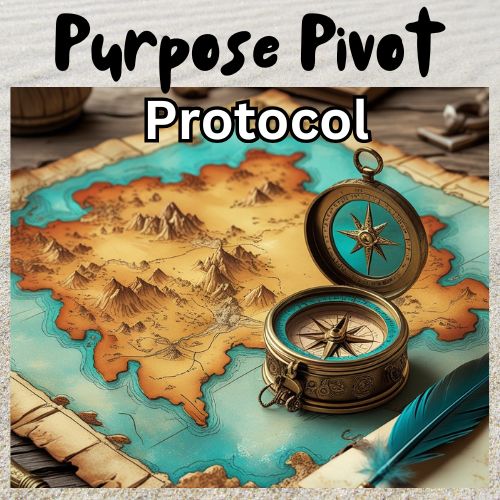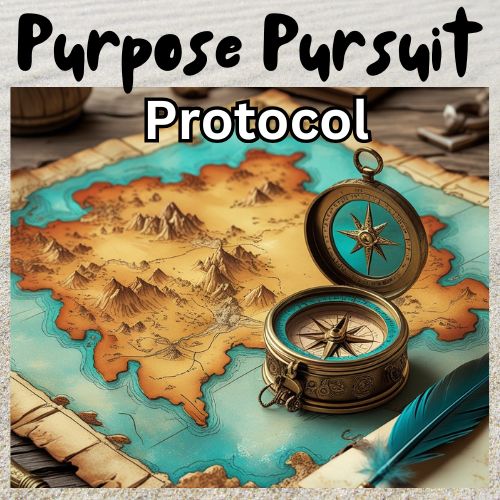From Corporate Burnout to Creative Breakthrough: The Missing Link Between Purpose and Innovation
Bite-sized Summary
Ever wondered why some days you’re creatively unstoppable while other days you feel like you’re drowning in mud? The solution might be simpler than you think. This article explores how discovering your life’s purpose acts as the ultimate creative catalyst, transforming blocked energy into flowing inspiration. Through the compelling story of Ella Mortimer’s transformation from corporate burnout to creative powerhouse, practical exercises, and actionable insights, you’ll discover how purpose and creativity can strengthen each other.
5 Key Takeaways
- Purpose acts as creative GPS – Without direction, creative energy scatters; with purpose, it flows like a river toward its destination
- Creative blocks often signal misaligned purpose – When what you’re creating doesn’t match who you are, resistance is inevitable
- Authenticity amplifies creative output – Work aligned with your values produces more innovative and impactful results
- Purpose provides creative courage – Knowing your “why” gives you the confidence to take bold, creative risks
- Regular purpose check-ins prevent creative stagnation – Like tuning an instrument, purpose needs periodic adjustment to keep creativity flowing
Picture this: You’re sitting at your desk, cursor blinking mockingly at you from a blank page. Your creative well feels drier than a comedian’s sense of humour at a funeral. Sound familiar? Now imagine that same cursor, but this time it’s practically vibrating with possibility, your fingers dancing across the keys as ideas flow like champagne at a New Year’s party. What changed? You discovered your purpose.
The Creative Paradox We All Face
Here’s something that’ll make you scratch your head: We live in the most creatively abundant time in human history, yet creative block has become as common as people who don’t use their turn signals. We have infinite tools, endless inspiration, and more opportunities than ever before. So why do so many of us feel creatively constipated?
The answer lies in a profound yet overlooked truth: Creativity without purpose is like a sports car without a destination – lots of power, nowhere meaningful to go.
Ella’s Story: From Corporate Zombie to Creative Dynamo
Let me tell you about Ella Mortimer, a 34-year-old marketing executive who embodied this creative paradox perfectly. For eight years, Ella climbed the corporate ladder with the enthusiasm of someone climbing toward their own execution. She was successful by every external measure – corner office, impressive salary, team of twelve – yet felt creatively bankrupt.
“I had all the resources in the world,” Ella recalls, “state-of-the-art design software, unlimited budget for campaigns, a talented team. But every morning felt like trying to squeeze water from a stone. I’d sit in brainstorming sessions feeling like a fraud, nodding along while internally screaming ‘Is this it?'”
Ella’s creative block wasn’t about lacking skills or tools. She was drowning in them. Her block was existential – she had no idea why she was creating what she was creating, beyond paying bills and climbing ladders that led to more of the same.
The turning point came during what Ella calls her “bathroom breakdown” – a moment of clarity that struck while she was hiding in the office restroom (because apparently, profound insights don’t wait for convenient locations).
“I realised I was pouring my creative energy into selling products I didn’t believe in, to people I didn’t understand, for reasons that had nothing to do with who I actually was,” she says. “It was like trying to write a love letter in a language you don’t speak.”
That breakdown became a breakthrough. Ella began what she calls her “purpose archaeology” – digging deep into what truly mattered to her. She discovered her authentic purpose: helping small businesses tell their stories in ways that create genuine community connections.
The transformation was immediate and dramatic. “It was like someone had been holding a dam back in my mind, and suddenly it burst,” Ella explains. “Ideas flooded in faster than I could capture them. I’d wake up at 3 AM, scribbling campaign concepts on the title page of the book I’d been reading.”
Within six months, Ella had launched her own boutique agency. Within two years, she’d helped over 200 small businesses find their voice and build meaningful customer relationships. Her creative output didn’t just increase – it exploded.
The Science Behind Purpose-Driven Creativity
Ella’s experience isn’t just feel-good inspiration – it’s backed by fascinating research. Neuroscientist Dr. Antonio Damasio’s work reveals that our brains are wired to create more efficiently when our actions align with our core values and sense of purpose.
“When we engage in purpose-driven activities, the brain releases a cocktail of neurochemicals including dopamine, norepinephrine, and endorphins,” explains Dr. Damasio. “This chemical symphony doesn’t just make us feel good – it literally enhances cognitive function, pattern recognition, and innovative thinking.”
Think of purpose as your brain’s preferred operating system. When you’re aligned with your purpose, you’re running on the neurological equivalent of high-octane fuel. When you’re not, you’re trying to run premium software on a potato.
Why Purpose Is Creativity’s Best Friend
1. Purpose Provides Direction
Imagine trying to navigate without a compass. You might walk for miles, but you’ll likely end up wandering in circles, exhausted and no closer to where you want to be. Creativity without purpose follows the same frustrating pattern.
“Creativity is not just about having ideas,” notes creativity researcher Dr. Mihaly Csikszentmihalyi. “It’s about having ideas that matter, that serve something larger than immediate gratification.”
When you know your purpose, creative decisions become clearer. Instead of asking “What should I create?” you ask “How can I create something that serves my purpose?” This shift transforms overwhelming possibility into focused potential.
2. Purpose Breaks Through Perfectionism
Here’s something perfectionism doesn’t want you to know: It’s not actually about creating perfect work. It’s about avoiding the vulnerability of creating authentic work. When you’re clear on your purpose, perfectionism loses its grip because you’re focused on serving something larger than your ego.
Ella experienced this firsthand: “When I was creating for corporate clients, I’d agonize over every detail because I had no idea what ‘good enough’ meant. But when I started creating for my purpose, I knew exactly when something was ready – when it effectively served the small businesses I was trying to help.”
3. Purpose Provides Creative Courage
Creating anything meaningful requires courage – the courage to risk failure, criticism, and the uncomfortable possibility that your work might not land as intended. Purpose provides this courage by giving you something worth risking for.
“The cave you fear to enter holds the treasure you seek,” wrote mythologist Joseph Campbell. Purpose helps you identify which caves are worth entering.
Exercise 1: The Creative Archaeology Dig
Time for some hands-on purpose detection. Grab a pen and paper (or your device of choice) and dig into these questions:
- Peak Creative Moments: Think of three times when you felt most creatively alive. What were you creating? For whom? What impact did it have?
- Energy Mapping: List your recent creative projects. Rate each on a scale of 1-10 for how energised you felt while working on it. What patterns do you notice?
- Values Alignment: What are your top five values? How do your current creative projects reflect (or fail to reflect) these values?
- Impact Visualisation: If you could wave a magic wand and create something that would positively impact 1,000 people, what would it be?
- The Deathbed Test: When you’re 95 and looking back on your creative life, what would you regret not creating?
Take your time with this exercise. Pour yourself something delicious, put on music that makes you feel expansive, and let your answers surprise you.
Exercise 2: The Purpose-Creativity Connection Map
This exercise helps you visualise how your purpose connects to your creative potential:
- Draw Your Purpose Core: In the centre of a large piece of paper, write your emerging sense of purpose (even if it’s still fuzzy).
- Add Creative Branches: Draw branches extending from your purpose core. On each branch, write different ways you could express this purpose creatively.
- Resource Mapping: Around each branch, note what resources, skills, or support you’d need to pursue that creative expression.
- Energy Assessment: Use colours to indicate which branches excite you most (green), which feel neutral (yellow), and which drain your energy (red).
- Next Steps: Circle the green branches that feel most accessible right now. These are your creative starting points.
The Four Stages of Purpose-Driven Creativity
Stage 1: Creative Confusion
You have creative impulses but no clear direction. Everything feels equally important or unimportant. This is where most people get stuck, mistaking motion for progress.
Stage 2: Purpose Glimpses
You start catching glimpses of what matters to you. Your creativity becomes more focused, but inconsistently. You’re learning to distinguish between creating for external validation versus internal alignment.
Stage 3: Purpose Alignment
Your creative work begins by consistently reflecting your values and goals. You develop what I call “purpose intuition” – the ability to quickly assess whether a creative opportunity aligns with your deeper intentions.
Stage 4: Purpose Mastery
You’ve integrated purpose so deeply that creativity flows naturally from who you are. You create not because you have to, but because you can’t not create. This is where Ella eventually landed.
Exercise 3: The Creative Energy Audit
This exercise helps you identify what’s currently blocking or boosting your creative energy:
Creative Energy Drains (Be brutally honest):
- Projects that feel meaningless
- Creating for audiences you don’t understand or care about
- Work that contradicts your values
- Creative environments that stifle authenticity
- Comparing your work to others
Creative Energy Boosters:
- Projects that align with your values
- Creating for people you genuinely want to help
- Work that lets you be authentically yourself
- Environments that encourage experimentation
- Focus on your unique creative voice
Now, audit your current creative life. What percentage of your creative energy goes to drains versus boosters? This ratio directly correlates with your creative output and satisfaction.
The Ripple Effect of Purpose-Driven Creativity
When Ella aligned her creativity with her purpose, something magical happened that she didn’t expect: Her work began creating ripple effects far beyond her immediate goals.
“I started noticing that the small businesses I helped weren’t just getting better marketing,” she explains. “They were becoming more connected to their own communities, creating jobs, and inspiring other entrepreneurs. My creative work was creating creative work in others.”
This is the multiplier effect of purpose-driven creativity. When you create from a place of authentic purpose, your work doesn’t just accomplish your immediate goals – it inspires others to pursue their own purposeful creativity.
Common Purpose-Creativity Myths Debunked
Myth 1: “Purpose must be grandiose” Reality: Purpose can be as simple as making people smile, solving everyday problems, or bringing beauty into ordinary moments.
Myth 2: “Purpose never changes” Reality: Purpose evolves as you grow. What mattered in your twenties might not resonate in your forties, and that’s perfectly normal.
Myth 3: “Creative success requires sacrificing purpose” Reality: The most sustainably successful creators are those whose work aligns with their deeper values and goals.
Myth 4: “Purpose-driven work pays less” Reality: While it might pay differently, purpose-aligned work often leads to greater long-term financial success because it’s more sustainable and authentic.
The Purpose Recalibration Process
Even when you think you’ve found your purpose, creative energy can still get blocked. This usually signals that your purpose needs recalibration – not replacement, but refinement.
Signs you need purpose recalibration:
- Previously exciting projects now feel routine
- You’re going through creative motions without emotional investment
- Your work feels disconnected from who you’re becoming
- You’re creating the same things in the same ways
The solution isn’t to throw everything out and start over. It’s to tune your purpose like you’d tune a guitar – making small adjustments that restore harmony.

The Purpose Pivot Protocol – drawing inspiration from the Camino de Santiago, this transformative course guides you through a proven framework to recalibrate your authentic purpose and create a meaningful and fulfilling next act. Get immediate access
Your Next Creative Chapter
Here’s what I want you to remember: Your creative block isn’t a character flaw, a lack of talent, or evidence that you’re not meant to create. It’s often your inner wisdom trying to tell you something important about alignment.
Ella’s story isn’t unique – it’s universal. Thousands of people are discovering that their creative struggles weren’t about lacking ideas or skills, but about lacking clarity on why those ideas and skills mattered.
“Once I knew my why,” Ella reflects, “the how became obvious, and the what became endless.”
Your creative energy is already there, waiting behind the dam of unclear purpose. The question isn’t whether you have enough creativity – it’s whether you’re ready to discover what you’re meant to create it for.

The Purpose Pursuit Protocol – if you want to discover your life purpose, this course will provide you with the clarity, motivation and direction you need to manifest your next chapter – in both your personal and professional life. Get immediate access
Frequently Asked Questions
Q1: What if I discover my purpose but it requires creative skills I don’t have? Skills can be learned, but purpose can’t be manufactured. Once you’re clear on your purpose, you’ll be amazed how quickly you can develop the skills needed to serve it. Purpose provides the motivation that makes skill development feel less like work and more like play.
Q2: How do I know if I’ve found my “real” purpose or just something that sounds good? Your body knows before your mind does. Real purpose feels like coming home – there’s a sense of relief, excitement, and rightness that you can’t fake. Purpose that’s just conceptually appealing but not authentically yours will feel forced, even if it sounds impressive.
Q3: What if my purpose doesn’t seem creative enough? Every purpose can be expressed creatively. Whether you’re called to help people, solve problems, or create beauty, there are countless creative ways to manifest that calling. The creativity isn’t in the purpose itself – it’s in how you choose to express it.
Q4: Can you have multiple purposes, and if so, how do you prioritise creatively? Yes, you can have multiple purposes, but usually one serves as your primary driver, with others supporting it. Think of it like a symphony – you have a main theme with supporting melodies. Your creative energy flows best when there’s a clear hierarchy.
Q5: What if my purpose changes? Does that mean I wasted time on previous creative work? Purpose evolution is growth, not failure. Previous creative work often provides the foundation and skills for your next chapter. Nothing is wasted – it’s all preparation for what’s coming next.
Conclusion
The relationship between purpose and creativity isn’t just philosophical – it’s profoundly practical. When you align your creative energy with your authentic purpose, you don’t just create more effectively; you create more meaningfully. You move from asking “What should I create?” to “How can I serve what matters most to me through my creativity?”
Ella Mortimer’s transformation from creatively blocked corporate executive to purpose-driven creative entrepreneur isn’t just inspiring – it’s instructive. It shows us that our creative struggles often aren’t about lacking talent, time, or tools. They’re about lacking clarity on why our creativity matters.
Your creative energy is already there, vast and waiting. The question isn’t whether you have enough creativity – it’s whether you’re ready to discover what you’re meant to create it for.
The dam is ready to break. Are you ready for the flood?
Ready to discover your creative catalyst? Join us in The Purpose Pursuit Protocol if you’re still searching for your life’s direction, or The Purpose Pivot Protocol if you need to recalibrate your existing purpose. Because life’s too short to create without conviction, and your creativity is too valuable to waste on purposes that aren’t truly yours.

“I am an experienced medical doctor – MBChB, MRCGP, NLP master pract cert, Transformational Life Coach (dip.) Life Story Coach (cert.) Stress Counselling (cert.) Med Hypnotherapy (dip.) and EAGALA (cert.) I may have an impressive number of letters after my name, and more than three decades of professional experience, but what qualifies me to excel at what I do is my intuitive understanding of my clients’ difficulties and my extensive personal experience of managing major life changes using strategies I developed over many years.” Dr M Montagu
References
Tobore TO. On creativity and meaning: The intricate relationship between creativity and meaning in life and creativity as the means to repay existential debt. Commun Integr Biol. 2025 Mar 30;18(1):2484526.
Sawyer, R.K. (2006). Explaining Creativity: The Science of Human Innovation. New York: Oxford University Press.
Keith, M. G., & Jagacinski, C. M. (2023). Tell Me What To Do Not How To Do It: Influence of Creative Outcome and Process Goals on Creativity. The Journal of Creative Behavior, 57(2), 285-304.
Tan CY, Chuah CQ, Lee ST, Tan CS. Being Creative Makes You Happier: The Positive Effect of Creativity on Subjective Well-Being. Int J Environ Res Public Health. 2021 Jul 6;18(14):7244.
Sternberg, R.J., Grigorenko, E.L., Singer, J.L. (Eds.). (2004). Creativity: From Potential to Realization. Washington, DC: APA.
Sato, K., Yang, K., & Ueda, K. (2024). Impact of the quality and diversity of reference products on creative activities in online communities. Scientific Reports, 14(1), 1-12.

